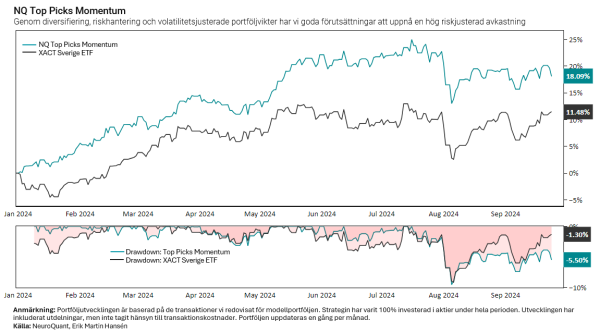Update: Top Picks Momentum

Top Picks Momentum buys and sells stocks based on our Pure Momentum strategy. This strategy identifies low-volatility uptrends, with the assumption that these trends often last longer than expected.
While momentum strategies do not always perform optimally every year, our studies show that volatility-adjusted momentum, combined with risk-adjusted portfolio weights, has historically outperformed indices over longer periods of time.
The holdings in the portfolio are based on momentum rankings from the Pure Momentum website. The strategy also allows for discretionary decisions, which means we have the option to exclude certain stocks that do not meet our requirements for various reasons.
Comment
In 2024, Top Picks Momentum has performed better than the Stockholm Stock Exchange, but weaker than the Value & Momentum and Volatility & Quality strategies. The sinkers during the year have been Wästbygg, XSpray and CTT Systems. The best positive contributors have been Ambea, VBG Group and ITAB.
Statistik, Year to Date:
- Return: +18.1% (+11.5%)
- Sharpe: 1,69 (0.77)
- Sortino: 1.27 (0.68)
- Volatility 11.8% (12.2%)
- Tracking error: 11% (0,00%)
- Max decline: -10% (-9%)
Development, Year to Date:
Last month, Top Picks underperformed the Stockholm Stock Exchange with a decline of 1% compared to the Stockholm Stock Exchange which rose by 1.6%.
- The biggest positive contributors have been Millicom (+0.43%), AAK (+0.37%) and Hoist Finance (+0.33%)
- The biggest declines have been Wästbygg (-0.38%), Hexatronic (-0.38%) and Bergman & Beving (-0.29%).
Tracking error against the index has been 11% in 2024. The portfolio currently has an overweight towards healthcare, tech and real estate and an underweight towards engineering and finance.
Changes
Momentum strategies sell stocks that no longer rank high on momentum and pick up stocks with stronger momentum. We systematically buy according to our target weights that take into account how much the stock fluctuates, thereby allocating more risk in a holding with lower volatility.
Due to lower momentum scores than 50, we have sold the following holdings:
Login required to view holdings in our stock strategies
Not a customer? Open an account to access our analytics service.
PROCESS AND METHODOLOGY
Our systematic equity strategies follow clear rules based on quantitative metrics, which minimizes the need for subjective judgments. This makes it possible to have a consistent and repeatable investment strategy, without letting emotions influence decisions.
Holdings and position sizes are included in the premium subscription. We have chosen not to share the exact rules for our stock strategies, Top Picks, Value & Momentum and Volatility & Quality. However, we offer many other strategies that we are happy to share.
The Top Picks, Value & Momentum and Volatility & Quality strategies are based on factors that we believe will work over time, but not necessarily in all periods. Factor-based strategies aim to outperform the market by identifying systematic patterns in stock prices and fundamental data. All quantitative strategies will experience weaker periods, and this is something we must accept and manage.
Factor-based investment methods are supported by extensive academic and empirical research.
We diversify and do not speculate on which holdings will perform better than others. All holdings are treated equally, meaning that each position has the same theoretical potential to affect the portfolio. We achieve this by adjusting the weight of the holdings based on their volatility. A stock with high volatility is therefore given a lower weight in the portfolio.
Strategies that apply monthly rebalancing do not have traditional stop losses. If a holding has fallen out of ranking during monthly rebalancing, the stock is sold. GRAPH Our systematic stock strategies are updated approximately once a month.
FREQUENTLY ASKED QUESTIONS (FAQ)
Where can I find holdings and portfolio weights?
You can find our holdings and weights on the Model Portfolios page. You can also filter the model portfolios via the watchlists on several pages in the platform.
How should you use your strategies?
Our strategies aim to provide inspiration and increase understanding of how to work with rules-based portfolios that are rebalanced monthly.
Is it possible to replicate a strategy 100%?
It is possible to follow the strategies if all changes and rebalancing are carried out according to our updates. However, some deviations may occur because buy and sell transactions are made at different rates, and transaction costs in the form of brokerage, exchange fees and slippage are added. Our recommendation is not to copy someone else's strategy, but to use the acquired knowledge to make your own decisions using the tools we offer on the platform.
How often are the strategies updated?
Our equity strategies are updated approximately once a month. The frequency is a trade-off between several factors, such as transaction costs and administration, which are weighed against the advantage of frequently resetting risk. For the strategies we offer today, rebalancing once a month works well. If a stock falls by 20%, this means a decline in the portfolio by 1% if we have 20 stocks in the portfolio with a 5% weighting in each. Major price drops are not a disaster unless we have very concentrated portfolios.
Do I always have to rebalance if the target weight deviates?
Rebalancing is done to restore the risk that has been allocated. For example, we allocate 0.10 (10 bps) to each holding. If the target weights do not deviate significantly from your current portfolio, you can save time and transaction costs by not rebalancing. However, remember that your portfolio performance will differ from ours if your portfolio weights deviate.
Do you include dividends and transaction costs?
We report total returns including dividends. For simplicity, however, we have not included transaction costs in the performance. Commissions are currently low at most brokers and we only make changes once a month. However, you should be aware of slippage and currency exchange fees.
Do you have to follow all the strategies?
No, you don't have to. The important thing is that you have time to manage your portfolios, even during weaker periods when it's more tedious to log in to your account. We currently have 3 stock strategies. This can change. Over time, these strategies have a high correlation with the stock market. After all, we buy stocks. Follow the concept that you believe in. Learn to make your own decisions. If you don't strongly believe in the concept, you won't follow the strategy during weaker periods. The best strategy is the strategy we can maintain over time.
What do volatility-adjusted weights mean?
We want to treat all companies in the portfolio equally, i.e. all companies should have an equal theoretical chance of affecting the portfolio. We do this by adjusting the weight of holdings according to the volatility of the stock. A stock that fluctuates a lot will therefore have a lower weight in the portfolio. If we were to weight all holdings equally, the most volatile stocks would characterize the development of the portfolio and this is not optimal unless the holdings have the same volatility. This method also leads to us reducing the position size in holdings that are starting to fall because declines often covary with increased volatility.
Do you use stop unloaders?
No, we do not use stop losses in the Top Picks, Value & Momentum or Volatility & Quality stock strategies. If a holding falls out of the ranking during the monthly rebalancing, the stock is sold. But there are no stop losses. For shorter strategies such as swing trading, we recommend stop losses. This means that before entry, you determine a level at which you will sell if the position goes against you, either directly in the software or by recording the level.
RISK WARNING
Investing in financial markets always involves risk. Past performance is no guarantee of future results, and there is a possibility that you may lose all or part of your invested capital. Our analyses and indicators are based on historical data and statistical models, but these models cannot predict future market movements with complete certainty.
The value of investments may fluctuate significantly due to market conditions, company-specific factors and global economic events. It is important that you carefully consider your financial situation and your ability to bear potential losses before investing. The Service does not provide personal investment advice and recommends that you seek independent financial advice before making any investment decisions.
NeuroQuant employees may own or trade securities mentioned in analyses or based on indicators used in our services. This may potentially create conflicts of interest, but we strive for full transparency and professional integrity in all our activities. Following our analyses and indicators involves increased risk if the market moves in an unpredictable manner. You should only invest money that you are prepared to lose and understand that past performance, analyses or models provided through the service do not guarantee future results.
